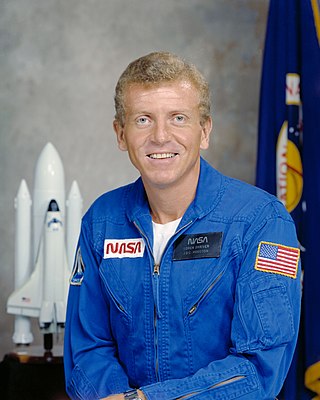
Loren James Shriver is a former NASA astronaut, aviator, and a retired US Air Force Colonel.

John McCreary Fabian is a former NASA astronaut and Air Force officer who flew two Space Shuttle missions and worked on the development of the Shuttle's robotic arm. He later led the Air Force's space operations.

Thomas Patten Stafford was an American Air Force officer, test pilot, and NASA astronaut, and one of 24 astronauts who flew to the Moon. He also served as Chief of the Astronaut Office from 1969 to 1971.

Simon "Si" Ramo was an American engineer, businessman, and author. He led development of microwave and missile technology and is sometimes known as the father of the intercontinental ballistic missile (ICBM). He also developed General Electric's electron microscope. He played prominent roles in the formation of two Fortune 500 companies, Ramo-Wooldridge and Bunker Ramo Corporation.

Bradford Parkinson is an American engineer and inventor, retired United States Air Force Colonel and Emeritus Professor at Stanford University. He is best known as the lead architect, advocate and developer, with early contributions from Ivan Getting and Roger Easton, of the Air Force NAVSTAR program, better known as Global Positioning System.
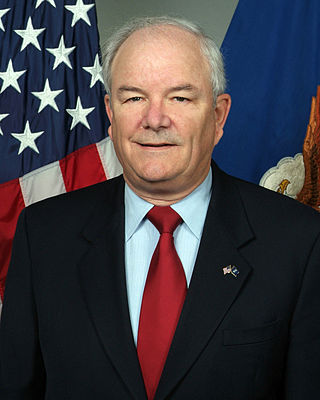
Michael Walter Wynne is an American politician and business executive and was the 21st United States Secretary of the Air Force. Secretary of Defense Robert Gates asked for and received his resignation on June 5, 2008, in the wake of the 2007 United States Air Force nuclear weapons incident and the mistaken shipment of Minuteman III parts to Taiwan in 2006, followed by an investigation by and a critical report from Admiral Kirkland H. Donald regarding the Minuteman incident.
The Oklahoma State University College of Engineering, Architecture, and Technology serves as the engineering, architecture, and technology components of OSU-Stillwater in Stillwater, Oklahoma, and OSU-Tulsa in Tulsa, Oklahoma. and is the only combined Engineering, Architecture, and Technology college in the United States. The Advanced Technology Research Center (ATRC), a relatively new addition to the college, has worked with business and industry in the areas of web handling, energy storage and conversion, manufacturing and other fields.

Samuel Cochran Phillips was a United States Air Force general who served as Director of NASA's Apollo program from 1964 to 1969, as commander of the Space and Missile Systems Organization (SAMSO) from 1969 to 1972, as the seventh Director of the National Security Agency from 1972 to 1973, and as commander of the Air Force Systems Command from 1973 to 1975.

Richard P. Hallion is Senior Adviser for Air and Space Issues, Directorate for Security, Counterintelligence and Special Programs Oversight, the Pentagon, Washington, D.C. He is responsible for analysis and insight regarding the conceptualization, evolution and utilization of sensitive national technological programs and related subject areas.

Siva Subrahmanyam Banda is an Indian-American aerospace engineer. He was Director of the Control Science Center of Excellence and Chief Scientist for the Aerospace Systems Directorate at the United States Air Force Research Laboratory at Wright-Patterson Air Force Base. He has taught at Wright State University, the University of Dayton, and the Air Force Institute of Technology.
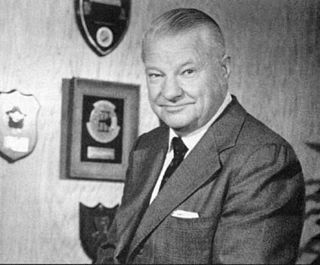
Clarence Leonard "Kelly" Johnson was an American aeronautical and systems engineer. He is recognized for his contributions to a series of important aircraft designs, most notably the Lockheed U-2 and SR-71 Blackbird. Besides the first production aircraft to exceed Mach 3, he also produced the first fighter capable of Mach 2, the United States' first operational jet fighter, as well as the first fighter to exceed 400 mph, and many other contributions to various aircraft.
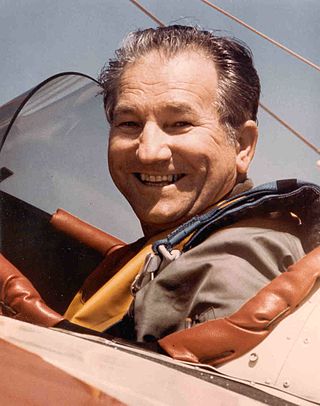
Joseph John "Tym" Tymczyszyn was an American World War II pilot, and test pilot for the United States Army Air Corps and the Federal Aviation Administration.
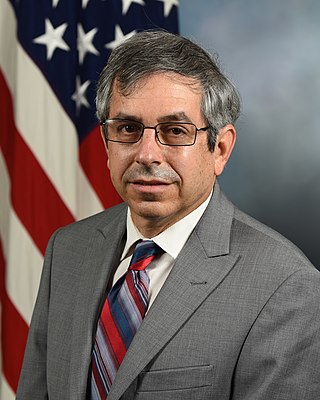
Ulfila Mark J. Lewis is a senior American aerospace and defense executive with special expertise in hypersonics. He is currently the Executive Director of the National Defense Industrial Association's Emerging Technologies Institute, following his role in the second half of 2020 as the acting US Deputy Under Secretary of Defense for Research and Engineering, and before that the Director of Defense Research and Engineering for Modernization. He was the Chief Scientist of the U.S. Air Force, Washington, D.C. from 2004 to 2008 and was the longest-serving Chief Scientist in Air Force history. He served as chief scientific adviser to the Chief of Staff and Secretary of the Air Force, and provided assessments on a wide range of scientific and technical issues affecting the Air Force mission. In this role he identified and analyzed technical issues and brought them to attention of Air Force leaders, and interacted with other Air Staff principals, operational commanders, combatant commands, acquisition, and science & technology communities to address cross-organizational technical issues and solutions. His primary areas of focus included energy, sustainment, long-range strike technologies, advanced propulsion systems, and workforce development.

Michael Ihor Yarymovych is President of Sarasota Space Associates, an aerospace consultant providing services to the aerospace industry and government. He is Senior Fellow of the United States Air Force Scientific Advisory Board (SAB) and has served on numerous SAB and Defense Science Board studies.
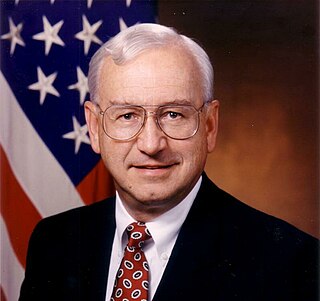
Paul Garrett Kaminski is a technologist and former U.S. government official, best known for his leading role in the development of stealth aircraft.

William S. "Bill" Mark is a vice president at SRI International, where he has been in charge of their Information and Computing Sciences Division since 1998.
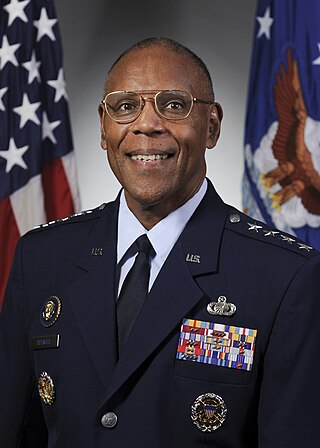
Larry Oneil Spencer is a retired United States Air Force general who served in many command, comptroller, and leadership roles during the course of his career. Some of his leadership roles included being the Vice Chief of Staff of the United States Air Force, commander of the 75th Air Base Wing at Hill AFB, commander of the 72nd Support Group at Tinker AFB, and the commander of the 4th Comptroller Squadron at Seymour Johnson AFB. He retired 1 October 2015 after more than 44 years of service. He received the Defense Distinguished Service Medal, the Air Force Distinguished Service Medal, the Defense Superior Service Medal, and the Legion of Merit.

James Julius Spilker Jr. was an American engineer and a consulting professor in the aeronautics and astronautics department at Stanford University. He was one of the principal architects of the Global Positioning System (GPS). He was the co-founder of the space communications company Stanford Telecommunications, and later was the executive chairman of AOSense Inc., Sunnyvale, CA.

John Francis McCarthy Jr. was an American scientist and engineer. He worked for the Massachusetts Institute of Technology as director of its Center for Space Research; the National Aeronautics and Space Administration (NASA) as the director of its Lewis Research Center; the United States Air Force, where he served with the Strategic Air Command and as a member of the United States Air Force Scientific Advisory Board; North American Rockwell, where he oversaw the design and development of the Apollo command and service module that took the first men to the Moon, and the S-II of the Saturn V rocket. His work doubled, and in the case of the Lockheed C-5 Galaxy, tripled, the service life of aircraft.

Khanh Dai Pham is a Vietnamese-born American aerospace engineer. He is noted for his work in statistical optimal control theory, game-theoretic operations research of military satellite communications, space control autonomy, and space domain awareness and the government leadership in innovation ecosystem and coalition of government agencies, small business and industry. He is a Fellow of the Air Force Research Laboratory (AFRL), the National Academy of Inventors (NAI), the Institution of Engineering and Technology (IET), the Society of Photo-Optical Instrumentation Engineers (SPIE), the Royal Aeronautical Society (RAeS), the International Association for the Advancement of Space Safety (IAASS), and the Royal Astronomical Society (RAS). He is not only a Fellow of the Institute of Electrical and Electronics Engineers (IEEE), the American Astronautical Society (AAS), and the Asia-Pacific Artificial Intelligence Association (AAIA) but also an Associate Fellow of the American Institute of Aeronautics and Astronautics (AIAA) and the Royal Institute of Navigation (RIN).



















